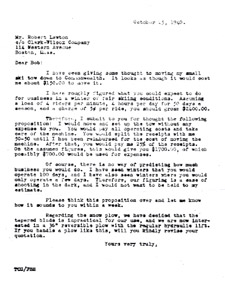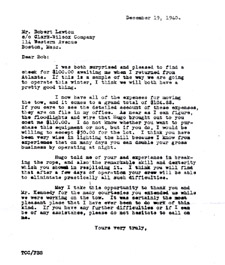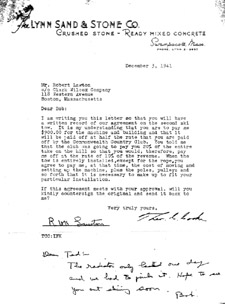


Newton
Commonwealth Part 1
Newton, MA
1940-1950's
History ~ Memories ~ Recent Photos
The Newton Commonwealth golf course was the location of a small rope tow ski area in the 1940's and 1950's. We are not quite certain if it operated, closed, then reopened, or if the operation was continuous, but research continues.
We begin with the opening of the ski area. Thanks to Phil Cooke, who has relayed to us the details of this operation.
During the fall of 1940, Theodore Cooke, who had owned and operated the Mt. Gunstock Ski Hoist, decided to sell the lift. He did this as the hoist was not very profitable, and to also be closer to his family. He contacted a Mr. Robert Lawton at the Newton Commonwealth Golf Course to sell the lift in October of 1940. To move the lift cost $150.00. In a letter to Mr. Lawton, Cooke estimated that 4 skiers could ride the lift per minute, for four hours a day, for fifty days a season, and at a charge of 5 cents per ride, could gross $2400.00.
Cooke made a proposal with Lawton, where he would move the lift without cost, with Lawton taking on all the operating and maintenance costs of the lift. The profits would be split 50-50 until the cost of moving the lift was paid. After that, Cooke would receive 25 percent of the receipts. Cooke estimated that some seasons the Commonwealth tow could operate 100 days, and others, just a few. It is unknown if this deal was accepted.
By December, Lawton had paid Cooke $100.00 to move the tow, so it assumed that another deal was stuck, and it appears that Cooke was able to receive 25% of one half of the profits. Floodlights from the Hoist were also sold for approximately $50.00. While night skiing was new, it was already well known at that time that night skiing was very beneficial to increasing operating hours and profit.
For the 1940-1941 season, it is known that 2,157 tickets, at $1.00 each, were sold at Commonwealth. Also, 3,735 five cent tickets were sold, for a total of $186.75. Cooke's profit for that year was $316.32.
For the following 1941-1942 season, Cooke was contracted out to build a new tow and operating building for $900.00. Lawton would pay Cooke the cost of installation, towers, pulleys, and so forth at the time the rope was ready to be installed.
Read the letters from Ted Cooke to Robert Lawton - click on each for the larger version:
|
|
On Feb 20, 1952, the ski operated with packed powder conditions on a 6-8 inch base. There was also night skiing. Check out the ski report on the left, sent to NELSAP by Dave Vaillancourt. |
The ski area lasted into the 1950's, but had closed by the end of the decade. Possible reasons include a lack of snow, growth of other nearby smaller areas, and changes at the golf course.
Phil Cooke shares his personal memories:
In the fall of 1940 my father, Theodore C. Cooke sold his Mt. Gunstock Ski Hoist contraption to a Mr. Lawton.
The reasons for selling: my mother with four children had enough of my father taking off every winter weekend to run the tow at Guilford. His weekday job was owning and operating a stone quarry in Swampscott, MA.
There was no snow in Newton that winter until February 1941. I distinctly remember my father saying "Let's see how my old ski tow is doing." So, we drove the fifteen miles from Swampscott to Newton. There was a large crowd of skiers mostly standing around. A few were skiing. Only a few were riding the tow including 8 year old me. On the way back home my father said "The Newton Tow grossed more in 1 day than I did in a whole year at Gunstock!"
Will Hynes: My name is Will Hynes and spent most of my teen years (the 1940's) on the Country Club property, caddying during the Spring, Summer and Fall, and working on the ski tow during the Winter. The Commonwealth Country Club was located on the Newton - Boston line very close to the terminus and car barns of the Commonwealth Avenue (now the Green Line) public transportation system. In those days, cars were far less prevalent than they are today, and many skiers would arrive after riding on the line and then trudging a quarter of a mile to the top of the slope. This was dedication. An assignment I had during the session's first hour was to sell each person a ticket, much like the tickets you see today. Most evenings, this activity was routine, but I have memories of below zero, windy times when making change required a talent for rapid dexterity.
There is no comparison to the equipment the
skier in the forties used and the equipment that is available today.
The length of your ski was determined by your height plus the extension
of your arm over your head. The width of the wooden ski was
about five inches. Your bindings usually consisted of one
strap on each ski to slip your feet into. If you were more
fortunate, you had a coil type binder with an adjusting clasp on one side.
If you were very fortunate, you had a simple ski boot (square toe) to go
into the binder. Poles were poles - no particular brand.
The clothes you wore were your everyday outerwear.
Since this was soon after the Second World War, it was common to see military
gear, e.g. field jackets, parkas, jump boots, etc. on the slopes.
The slope followed the contour of the first hole at the now defunct Commonwealth
Country Club. A golf course currently exists on most of what
was the original course, but major revisions, including those on the first hole,
will give a different picture as to what existed during those earlier years. The
first hole was about 350 yards long - from tee to green. It
was fairly steep from the tee area to about 50 yards from the green, making the
ski slope about 300 yards long. The flattened out area close
to the green enabled the skiers to form an arcing line at the slope's base while
awaiting a turn at the rope tow. It also meant that an
occasional runaway skier went crashing into the line. On a
busy afternoon the line was quite long and would mean a wait of at least 15
minutes for a ride.
The tow itself consisted of hemp rope close to an inch in diameter.
It was pulled by a 1936 Ford truck engine which, on occasion, was known
to break down. The rope along the side of the slope moved
along automobile tire rims affixed atop wooden poles spaced about 50 feet apart.
Night skiing was made possible by high intensity flood lights on each of
the tow poles. Another assignment I had on the slope was to
remain at the bottom of the tow to control the spacing so that there would be
about 40 feet between the riders. This assignment meant I
had to be alert for a skier who looked apprehensive about the lift.
A quick lesson of "slowly tighten your grip before you grab the rope" was
all you could say. Unfortunately, a quick grab meant a
sudden surge forward with awkward results. Usually the skier
let go or just fell down, ready to try again. Once in awhile,
the skier would not let go, was spread-eagled, and was being dragged up the tow
trail. I could only shout "let go of the rope", and hope for
the best. Today, over fifty years later, when I hear or
think "let go of the rope", a smile will come to my face.
The Commonwealth slope had three periods of operation on a good weekend day.
9 - 12, 1 - 4, and 7 - 10. During the weekdays, it
was open 7 - 10. Cost for one period was one dollar.
We must remember that this was long before artificial snow.
If there was no snow, there was no skiing. Even if
there had been a snowstorm, and the slopes were packed with skiers, this would
mean that within a few days the slope conditions would deteriorate into rock
hard icy conditions or softer conditions (due to melting) that brought bare
spots. For a good skiing season, as I remember, you could
not count on more than 25 days when you could pleasurably hit the slopes.
Lew Flint: I happened to come across your website on the Commonwealth and it brought back many fond memories of my high school years caddying there during the forties for Russ Hale, the club pro. My claim to fame was being picked to caddy for Bing Crosby when he appeared there during a war bond drive. I was about 14 years old and he gave me a ten dollar bill with his autograph on it, which of course I immediately (and foolishly) spent.
Herb Marcus:
Recent Photos
Betsy McDonough and I found this ski area on Nov. 20, 1999. It was 68 degrees and
sunny when we stopped by, amazing for late November! The golf course was still
running and there were plenty of golfers out enjoying the day.
| Here are a few photos of the ski area. We believe that the ski tow ran up on the right side of the slope pictured on the right, but with many changes to the golf course over the years, that may not be the case. |
|
|
|
Here's a few from the top of the hill, looking into Newton. |
If you have any more information on this ski tow, please let us know!
Last updated: July 8, 2008